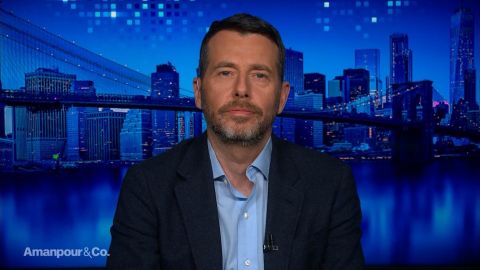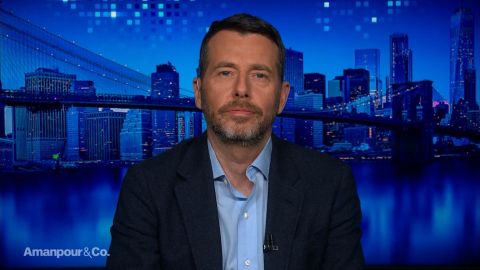Read Transcript EXPAND
CHRISTIANE AMANPOUR: And now, our next guest is known as a master virus hunter. Dr. W. Ian Lipkin is an infectious disease expert a Columbia University and he’s fresh out of quarantine after traveling to China where he was studying the coronavirus outbreak. This virus has now infected nearly 94,000 people around the world with more than 3,000 deaths, and it is far deadlier than the regular flu, so say, World Health officials. And now, Italy has closed all schools as its death toll reaches 107. In 2003, Dr. Lipkin helped Chinese authorities combat SARS. He was also an advisor on the film “Contagion,” which was a thriller inspired by epidemics. And Dr. Lipkin has been speaking to our Walter Isaacson about all of this.
WALTER ISAACSON: Dr. Lipkin, thank you for joining us. You’ve just come back from China. You’re a great virus hunter, famous. You’ve been over there ever since 2003 where you were working with the epidemic then. What did you see on this last trip to China?
W. IAN LIPKIN, DIRECTOR, CENTER FOR INFECTION AND IMMUNITY, COLUMBIA UNIVERSITY: It’s quite similar to what I saw in 2003. You have deserted streets, stores are vacant, restaurants are vacant, a lot of concern about transmission in the streets. People wearing masks everywhere. So, that was really quite similar. Of course, China is different in 2020 than it was in 2003. It’s far better developed. So, you know, the streets that used to be bicycles and so on are now filled with — you know, they’re all filled with cars. Except in this case, since the last time I was there, there were no cars at all.
ISAACSON: The SARS virus you were looking at in 2003, how similar is that to the coronavirus?
LIPKIN: So, they’re both coronaviruses. There have actually been three major coronaviruses that we’ve encountered as humans. The first, of course, was SARS in 2003 and then we had MERS in Saudi Arabia. I was involved in that outbreak as well and spent a lot of time in the kingdom. And then more recently now, this new SARS-CoV-2. So, they’re very similar, particularly the two SARS coronaviruses.
ISAACSON: And what is a coronavirus exactly? Does that mean it just has low crowns on the protein shell?
LIPKIN: Yes. So, most people don’t know what viruses are. So, it’s probably good to start with that. So, people talk about microbes or bugs or what have you, and that they lump everything together. So, we’ve got — we have fungi, we have bacteria and we have viruses. So, fungi are multi-cellular organisms and they have complex structures. Bacteria have the ability to grow on surfaces. They have everything they need in the way of collection of nutrients, ways to metabolize nutrients. Viruses, in contrast, are just pieces of genetic materials. They are obligate intracellular parasites. So, they have to get inside of a cell. They have to subvert the cell’s own machinery so they can reproduce themselves and go through their life cycle.
ISAACSON: So, in other words, it’s just simply a piece of DNA or RNA encoded in a little sort of case of protein?
LIPKIN: A little protein shell, yes.
ISAACSON: And they’re not really living organisms?
LIPKIN: They’re not living organisms, although many people think of them in those terms, and they have morphology. So, you know, we take typically Greek terms, but sometimes not to give them names. So, there are viruses called arenavirus. Arena mean Sam, like the arena in the coliseum, and they have a sort sandy appearance under electron microscopy. And coronaviruses have a shell of protein and there are little spikes of sugar that stick out that look like a crown.
ISAACSON: Why do they have the spikes of sugar?
LIPKIN: Those spikes of sugar are important for attaching to the cells that they subsequently infect.
ISAACSON: You just came back from China where you were studying this and you quarantined yourself for 14 days and Columbia University encouraged you to do so. Why did you do that? Where did you do it? What was it like?
ISAACSON: So, this is the second time that I’ve been isolated after returning from China. The first time was in 2003. When I came back in May and I was participating in a meeting. That there wasn’t any requirement, at that point, that I immediately go into isolation, but I was leading this meeting over the phone, because I knew I wasn’t feeling quite well. I started coughing. And I got a call from New York City Department of Health who said, we know you’re homing in but we’re just reinforcing the fact that you are not, you know, going back to work for at least another seven days. So, that was a 10-day isolation period. So, when I was planning to come back from China, I heard from my university, I spoke with various other people about what the current thoughts were and the guidelines were that the maximum incubation period at that point was thought to be 14 days. So, the idea, therefore, is if you get exposed to the virus and you wait 14 days and you don’t develop signs of disease, then you’re not going to develop disease and you’re not going to be capable of transmitting the virus. Now, this is probably strictly speaking not true, because we now know that there are people who can shed virus without developing signs of disease. But because I have a lab that does diagnostics, we took it one step further. So, for the last three days and at the beginning of my time in isolation, we checked nasal pharyngeal swabs using a very sensitive molecular test to see whether or not I had any virus infection, and I didn’t.
ISAACSON: Walk me through what happens when a coronavirus infects a person. It gets into a cell, It starts replicating itself. Tell me how that process works.
LIPKIN: It gets into a cell, it releases its payload, it reproduces the genetic material. That genetic material is assembled inside of a protein code using the machinery of the cell. It exits the cell, acquires an envelope, which is a cloak. It gets that characteristic appearance that we were talking about that looks, you know, crown like. That then attaches to another cell. The whole process repeats. In addition, this virus has the capacity to fuse cells. So, it can actually move from one cell to another without going through this extra cellular phase.
ISAACSON: So, that makes it a little bit faster?
LIPKIN: Makes it — it can make it even faster. And what it does then, in addition to damaging the airways directly, it induces immune responses. Those immune responses can be toxic. So, the one, which is basically a very thin layer of cells for gas exchange, so oxygen comes in and CO2 goes out, accumulates fluid, gets thicker, gets less pliable. The gas exchange becomes a problem. In addition, because you’ve got this infection, your body mounts an immune response and there are all sorts of proteins called cytokines that begin to circulate that cause damage in their own right.
ISAACSON: And when do I begin feeling something in this process?
LIPKIN: Well, people vary. Some people don’t feel anything. People have localized infection in the upper airways, they never progress to have pneumonia. It really is a question of how strong your immune system is, whether or not you have underlying lung disease or some other problem like cancer or diabetes that might impede the ability of the immune system to have an impact. And in other viral infections, not this one because we haven’t seen this one in the past, although SARS, interestingly, if you saw SARS you might have some protection. It’s not clear yet how people are protected, if they’ve seen a previous coronavirus infection. But in some of these infections, you just have a very, very mild disease.
ISAACSON: Now that the coronavirus is here in the United States, what should we be doing?
LIPKIN: So, because we don’t have a vaccine, the only thing we really have is those kinds of things which are practical and, frankly, should be obvious. You’re inside of a public conveyance, do you really want to hold on with your bear hand onto a strap in a subway or bus, whatever, probably not. I wear a glove when I use the subway. Things that people don’t think about as being contaminated like the, you know, remote control when you go to a hotel. These things are never cleaned up. When I fly, I wipe down all surfaces.
ISAACSON: Do you wipe it with alcohol or does alcohol kill viruses?
LIPKIN: I do. I wipe it down with alcohol.
ISAACSON: What about a chlorine product?
LIPKIN: Well, a chlorine product would work too but it’s quite smelly and it would also bleach out whatever you touch.
ISAACSON: Let’s say a Purell or a hand san that’s alcohol based —
LIPKIN: Any one of those —
ISAACSON: — tends to work against coronavirus?
LIPKIN: 60 percent to 70 percent alcohol works. And, you know, is it 100 percent? No, nothing is 100 percent. So, what we’re talking about here is mitigation. That’s what it’s all about. It’s all about mitigation until such time as we have some sort of definitive approach to deal with this.
ISAACSON: You’re also an adviser to the movie “Contagion,” which is — people should watch. It’s somewhat relevant to today. Tell me your thought. Should we be shaking hands these days? What should we be doing?
LIPKIN: Right now, all we really have is social distancing. It’s not full isolation, but we find ways in which we minimize certain types of contact. In that film, there’s a scene where the son of a CDC, you know, maintenance worker gets his vaccine. And Laurence Fishburne is having a conversation with this youngster and they go to shake hands and he says, you ever know where this came from? And the idea was, you know, in the Middle Ages, this is the way you showed that your sword arm was encumbered, and you didn’t have to worry, right? So this, unfortunately, means now that we — this is a potential threat. Why? Because people are continually touching their face. They’re putting their hands in their nose, their mouth, other mucus membranes. So, not only do I carry what’s down here to myself, and inoculate myself, but I then inoculate you. So, some of these things we do, which are part of our social mores, I think we’re going to have to forego for a while.
ISAACSON: So, in other words, you’re saying, in an age of pandemics, and especially viral ones, we should just quit shaking hands?
LIPKIN: We quit — well, here’s the thing I do. So, I do this.
ISAACSON: All right.
LIPKIN: That works fine.
ISAACSON: OK, cool.
LIPKIN: You know, if you want to shake hands. Otherwise, I think a fist bump or an elbow bump or simply, “Namaste,” whatever you want to do, probably a safer approach.
ISAACSON: How does this movie end?
LIPKIN: In “Contagion,” as you know, it ended with a vaccine. Now, I don’t think that this virus is ever going to disappear completely. I hope I’m wrong. I think it’s with us to stay. It would not surprise me if a substantial proportion of the world’s population ultimately became infected with this virus. And, as new children come into the world, they’re going to be susceptible. We have seen this with MERS coronavirus and camels. frankly, they’re not that different than humans. I mean, we’re all animals. As new populations come in and can be infected, this is a challenge, just like with measles. Do I think we’re going to lose the equivalent of the number of people we lost during the 1918 flu pandemic? No. That was a very different era. It’s true that more people may become exposed more rapidly with this virus. But we have antibiotics to treat secondary infections. We understand more about how viruses are transmitted, and we will have a vaccine. And I’m confident that, working together, pulling the world together in this fashion, and sharing information and sharing technologies, we will get to a vaccine in less than a year. We must get to a vaccine less than a year.
ISAACSON: Do you think, in some ways, there’s a good to come out of this, which is the sharing of information, in some ways making information go viral for a good cause, and that this will bring the world or our country together in these troubled times?
LIPKIN: There are number of silver linings to this cloud. One, I think you have already alluded to. I think it’s an opportunity for us to rally together behind science and politicians and others who need to work together for a common purpose. The other thing is that, internationally, we have an opportunity to realize the original goals of the international health regulations that were signed by every single nation-state in the United Nations back in 2005. And the precepts there were, every nation should be able to diagnose disease within its own borders, and everyone should be transparent in sharing those data. In 2003, China was incapable of doing what they did recently. They couldn’t have solved these problems. They solved them. And they have shared us data in as close to real time as possible. It’s been challenging to really follow the outbreak because the diagnostic methods have changed. So you want to know that you’re comparing comparable data from day to day. But if they were not being transparent, they would have told us the numbers were going down long before they did. Everyone knows that there’s no way to contain this kind of information anymore. You have to be transparent. So, that also is good. And we have a program which we’re trying to build that includes various developing nations globally called GIDEON. The idea there is that we’re going to share data. We do this in peacetime. We do this in wartime, so that, when there’s a challenge, everybody has the infrastructure and the trust to be able to move forward collaboratively. This is absolutely critical. And the last thing I would say on that topic has to do with the wild animal markets. The — this virus came from wildlife. It was not a biological weapon. It was not something that was inadvertently released by somebody who was developing biological weapons. This thing came from nature. And how did it come from nature? Because a wide range of things. And I will mention climate change here, because it’s critical too. With climate change, we’re seeing more and more people who are having food insecurity who are eating wildlife. You’re finding more mosquito-borne diseases. With the changes in temperature, certain types of mosquitoes, which were formerly restricted to the Tropics, are now moving up into temperate zones. So you’re seeing malaria moving further north. You’re seeing Zika. So it’s been one thing after another. We have to address these things. The easiest thing to do that I have been pushing since 2003, and the Chinese government is now pushing this forward, is, they’re going to be eliminating these wild animal markets, no more pangolins, no more civets. We’re not — no more bats. And it’s not just China. This is all over Asia. It’s all over Africa. And, frankly, we have done some work at JFK, where we have found people bringing in wild animals. And it’s — so, finger-pointing is not productive. We all need to stop this.
ISAACSON: And what can you and others in the scientific community do to make sure that, if there’s a vaccine, it’ll be affordable for people in the United States, but also for people around the world?
LIPKIN: So, I try to speak as loudly on this point as I can. And I come on programs like this one. And I stress the point. I say, look, there are two reasons to do this. Number one, it’s the right thing to do. But even if you don’t believe it’s the right thing to do, even if you view it from a selfish motive, you want to keep it contained. You don’t want it to come to threaten you in your backyard. And I had a conversation last night with a very, very wealthy individual. And we were talking about the fact that some of the people I know who have resources are building bunkers. And this guy said to me, I don’t believe in bunkers. And I said, good for you, because there is no bunker. There’s no way you can build a wall around the United States and keep this virus out.
ISAACSON: Dr. Lipkin, thank you for being with us.
About This Episode EXPAND
Former Obama campaign manger David Plouffe breaks down yesterday’s Super Tuesday results. Infectious disease expert Dr. W. Ian Lipkin tells Walter Isaacson how people can protect themselves from coronavirus. David Simon tells Christiane about his new HBO series “The Plot Against America,” based on the Philip Roth novel by the same name.
LEARN MORE


